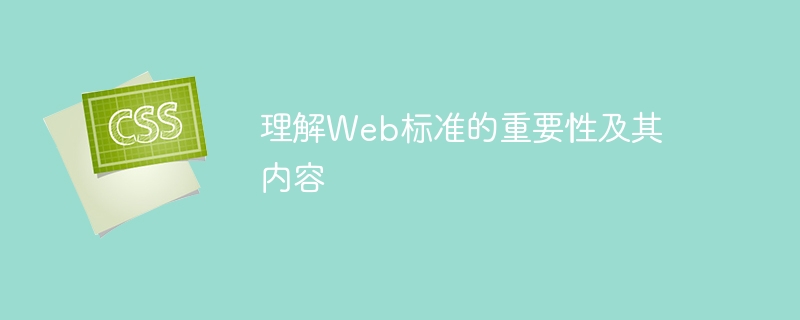Home >Web Front-end >CSS Tutorial >The importance of knowing and understanding web standards and their content
The importance of knowing and understanding web standards and their content
- 王林Original
- 2024-01-13 12:40:14709browse

Understanding the importance of Web standards and their content requires specific code examples
Web standards are a series of guidelines, rules, and specifications developed and promoted to ensure Compatibility and consistency between web pages, applications and different browsers on the Internet. Understanding the importance of web standards is critical for developers, designers, and content creators. The orderly use of web standards can not only improve development efficiency, but also provide a better user experience while reducing development and maintenance costs.
Web standards cover many aspects, including HTML (Hypertext Markup Language), CSS (Cascading Style Sheets), JavaScript, HTTP (Hypertext Transfer Protocol), XML (Extensible Markup Language), etc. In this article, we will discuss several important aspects of web standards in the form of concrete code examples.
First is HTML. HTML is the basic language used to build the structure and content of web pages. It defines a series of elements and attributes used to mark various parts of a web page, such as titles, paragraphs, images, links, etc. HTML uses simple opening and closing tags to define these elements, like this:
<h1>这是一个标题</h1> <p>这是一个段落。</p> <img src="/static/imghwm/default1.png" data-src="image.jpg" class="lazy" alt="图片描述"> <a href="https://www.example.com">这是一个链接</a>
Next comes the CSS. CSS is used to describe the appearance and style of web pages. It selects and modifies elements in web pages through a combination of selectors and attributes. Here is a simple CSS code example to set the color of the title text to red and the font of the paragraph text to Helvetica:
h1 {
color: red;
}
p {
font-family: Helvetica;
}Another important web standard is JavaScript. JavaScript is a client-side scripting language used to add interactivity and dynamics to web pages. Here is a simple JavaScript code example for displaying a tooltip when the user clicks a button:
function showMessage() {
alert("Hello, World!");
}HTTP is a protocol used to transfer data between a web browser and a web server. It defines the format of requests and responses and the handshake process. The following is a simple HTTP request example for requesting a web page from the server:
GET /index.html HTTP/1.1 Host: www.example.com
And finally the XML. XML is an extensible markup language used to describe, store and transmit structured data. The following is a simple XML example describing information about a book:
<book> <title>Web标准入门</title> <author>张三</author> <year>2022</year> </book>
These code examples are just a small sample of what is included in Web standards. Understanding the importance of web standards means understanding the role these specifications play in ensuring cross-browser compatibility, improving page performance, providing accessibility, enhancing search engine optimization, and more. At the same time, developers and designers should also follow the latest web standards and avoid using outdated technologies and methods.
In summary, understanding web standards is critical for developers, designers, and content creators. This article introduces important aspects of several web standards such as HTML, CSS, JavaScript, HTTP, and XML through specific code examples. By following web standards, we are able to provide a better user experience, increase development efficiency, and reduce maintenance costs.
The above is the detailed content of The importance of knowing and understanding web standards and their content. For more information, please follow other related articles on the PHP Chinese website!

